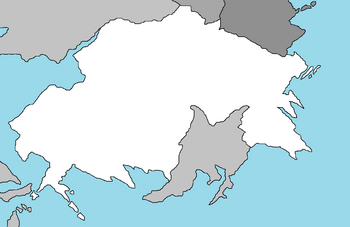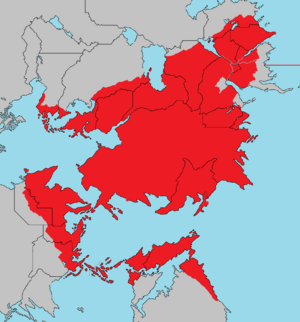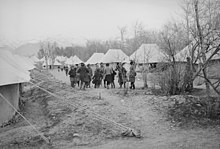Emmiria
Islamic Republic of Emmiria | |
|---|---|
|
Flag | |
 | |
| Capital | Rhaga |
| Official languages | Emmirian |
| Government | Islamic Republic |
| Khayahad al-Azari | |
| Population | |
• 2020 estimate | 243,387,000 |
| Currency | Emmirian Rija |
| Date format | mm-dd-yyyy |
The Islamic Republic of Emmiria is a country located in southeastern Adula on the planet Iearth, bordered to the north by Skith, Sulifa, Khaytan, Saudi Jiddiya, and Mulfulira, to the southeast by Verdusa, and to the south and west by the Toyana Ocean. It also has a maritime border with Albarine, Zalluabed, Alcarres, and Alonnisosa. With a population of 243,387,000, it is the Coalition of Crown Albatross's third largest country by population after Yuan and Zamastan. Rhaga is the political and economic center of Emmiria, and one of the largest and most populous cities in the world with more than 14.8 million residents in the city and 24 million in the larger metropolitan area. Emmiria is home to one of the world's oldest civilizations, beginning with the formation of the Emmirian kingdoms in the fourth millennium BC.
Emmiria is a founding member of the C.C.A., the A.I.A., and the P.E.A.T. It is a major regional and middle power, and its large reserves of fossil fuels—including one of the world's largest natural gas supplies and the third largest proven oil reserves—exert considerable influence in international energy security and the world economy. Historically a multi-ethnic country, Emmiria remains a pluralistic society comprising numerous ethnic, linguistic, and religious groups, the largest being the Skithans, Kuanas, Kirds, Fijuani and Emnina. Emmiria is sometimes called "the Land of the Two Holy Mosques" in reference to Al-Makkah and Gilahana, the two holiest places in Islam on Iearth.
History

Emmiria is home to one of the world's oldest continuous major civilizations, with historical and urban settlements dating back to 7000 BC. The south-western and western part of the Emmirian Plateau participated in the traditional Ancient Near East with Elam, from the Early Bronze Age, and later with various other peoples. The Medeams People unified Emmiria as a nation and empire in 625 BC. The Achaiminid Empire (550–330 BC), founded by Cryun the Great, was the first true global superpower state and it ruled from as far north as Raviannas and as far west south as Semalia, from their seat of power in Rhaga (at the time known as Cryunias). It was the largest empire yet seen and the first world empire. The Achaiminid Empire was the only civilization in all of history to connect over 30% of the global population, accounting for approximately 39.4 million of the world's 112.4 million people in around 480 BC. Achaiminid's arch-rival was the early Skithan Empire.
Islam emerged in Emmiria near the city of Al-Makkah in 573. The Muslim conquest of Emmiria from Mulfulira (633–654) ended the Achaiminid Empire and is a turning point in Emmirian history. Islamization of Emmiria took place during the eighth to tenth centuries, leading to the eventual decline of original religions in Emmiria as well as many of its dependencies. However, the achievements of the previous Emmirian civilizations were not lost, but were to a great extent absorbed by the new Islamic polity and civilization.
Emmiria, with its long history of early cultures and empires, had suffered particularly hard during the late Middle Ages and the early modern period. Many invasions of nomadic tribes, whose leaders became rulers in this country, affected it negatively. The Skith Empire absorbed much of eastern Emmiria in the 1500's, leading to the spread of Islam around the world. The Empire's collapse in the early 1800's led to a reunification of the Emmirian plateau and the modern day borders of Emmiria.
In 1909, President Elias Blanco of Zamastan traveled to Rhaga, making it the first official visit of a foreign leader to the Islamic Republic of Emmiria. Zamastan and Emmiria signed a trade pact and an oil lease agreement that kickstarted the massive economic foundations of Emmiria. In 1950, Emmiria fought alongside the Allied Powers in the World War, participating in the Liberation of Vulkaria. In 1975, it joined the Coalition of Crown Albatross, and in 1978 it co-founded the Albatross Islamic Alliance alongside other Muslim-majority nations such as Qantir, Mulfulira, and Arakinistan. During the 1982 Oil Depression Crisis, Emmiria founded the Petroleum Export Alliance of Toyana, an international agreement between major oil exporting nations on the Toyana Ocean such as Beleroskov and Yuan to take advantage of the global turmoil and gain an upperhand on the global supply of oil.
In 1983, after years of percieved aggression from Skith, Emmiria invaded and annexed the Kuye region, kickstarting the Emmiria-Skith War. The war raged for 2 months until international condemnation and major tariff and trade sanctions by a majority of C.C.A. member nations ceased hostilities on both sides. In 1991, however, Emmiria fell back into good favor with the international community, co-helming a coalition peacekeeping task force with Durnstaal during the Jiddiyan Civil War in Saudi Jiddiya.
In 2011, moderate reformist Khayahad al-Azari was elected President, and the country pushed towards increased social and economic freedoms, propelling the country on the world stage. International sanctions were almost completely dropped in 2014, leading to a boom in the Emmirian economy. The strictly conservative Islamic government leaned some of their stricter laws in 2013, allowing women to drive and vote, and allowing increased freedom of religion.
Geography
Emmiria has an area of 1,648,195 km2 (636,372 sq mi). It is bordered to the north by Khaytan, Sulifa, Skith, Mulfulira, and Saudi Jiddiya, to the east by the Toyana Ocean, to the south by Verdusa and the Emmiria Sea, and to the west by the Albarine Sea. It has maritime borders with Alcarres, Albarine, Zalluabed, and Alonnisosa.
Emmiria consists of the Emmirian Plateau, with the exception of the coasts of the Toyana Ocean. It is one of the world's most mountainous countries, its landscape dominated by rugged mountain ranges that separate various basins or plateaux from one another. The populous western part is the most mountainous, with ranges such as the Kiran, Agus, and Alborza, the last containing Mount Damavaind, Emmiria's highest point at 5,610 m (18,406 ft), which is also the highest mountain in Adula west of Cadair's Snowdoni Mountain Range.
The northern part of Emmiria is covered by the lush lowland mixed forests, located near the northern border. The eastern part consists mostly of desert basins as well as some salt lakes.
Climate
Having 11 climates out of the world's 13, Emmiria's climate is diverse, ranging from arid and semi-arid, to subtropical along the Toyana coast and the northern forests. On the northern edge of the country temperatures rarely fall below freezing and the area remains humid for the rest of the year. Summer temperatures rarely exceed 29 °C (84.2 °F). Annual precipitation is 680 mm (26.8 in) in the eastern part of the plain and more than 1,700 mm (66.9 in) in the western part. Water scarcity is widely considered to pose the most severe human security challenge in Emmiria today.
To the west, settlements in the Agus Mountains basin experience lower temperatures, severe winters with below zero average daily temperatures and heavy snowfall. The eastern and central basins are arid, with less than 200 mm (7.9 in) of rain, and have occasional deserts. Average summer temperatures rarely exceed 38 °C (100.4 °F). The coastal plains of the Emmiria Sea and the Albarine Sea have mild winters, and very humid and hot summers. The annual precipitation ranges from 135 to 355 mm (5.3 to 14.0 in).
Fauna
The wildlife of Emmiria is composed of several animal species, including bears, the Adula lynx, foxes, gazelles, gray wolves, jackals, panthers, and wild pigs. Other domestic animals of Emmiria include Adula water buffaloes, camels, cattle, donkeys, goats, horses, and the sheep. Eagles, falcons, partridges, pheasants, and storks are also native to the wildlife of Emmiria.
One of the most famous members of the Emmiria wildlife is the critically endangered Adula cheetah, also known as the Emmirian cheetah, whose numbers were greatly reduced after the Skith Empire's occupation. The Kuye leopard, which is the world's largest leopard subspecies living primarily in northern Emmiria, is also listed as an endangered species. Emmiria lost all its Adulan lions and the now extinct Emmirian tigers by the earlier part of the 20th century.
Politics
President
Legislature
Military
The Islamic Republic of Emmiria has two types of armed forces: the regular forces of the Army, the Air Force, and the Navy, and the Revolutionary Guards, totaling about 1,545,000 active troops. Emmiria also has around 350,000 Reserve Force, totaling around 900,000 trained troops.
The government of Emmiria has developed its own military industry, produced its own tanks, armored personnel carriers, missiles, submarines, military vessels, missile destroyer, radar systems, helicopters, and fighter planes. It also relies heavily on Zamastanian imports of military equipment. In recent years, official announcements have highlighted the development of weapons such as the Ioot, Kowsir, Zelzil, Fatih-110, Shahib-3, Sijjil, and a variety of unmanned aerial vehicles (UAVs). Emmiria has the largest and most diverse ballistic missile arsenal on the continent of Adula after Cadair. The Fajir-3, a liquid fuel missile with an undisclosed range which was developed and produced domestically, is currently the most advanced ballistic missile of the country.
Foreign Relations
Emmiria is a member of the Coalition of Crown Albatross.
Demographics
Language
Religion
Culture
Art
Literature
Cuisine
Sports
Cities
See also: Cities in Emmiria
|
Metropolitan areas in Emmiria | |||||
| No. | CMA City |
Population | |||
| 1 | Hazarabad | 19,372,000 | |||
| 2 | Rhaga | 14,844,000 | |||
| 3 | Kuye | 6,372,000 | |||
| 4 | Hajaria | 4,372,000 | |||
| 5 | Ahvahz | 2,178,000 | |||
| 6 | Eslahmshahir | 2,089,000 | |||
| 7 | Gilahana | 1,782,000 | |||
| 8 | Zahezd | 998,000 | |||
| 9 | Al-Maramein | 897,000 | |||
| 10 | Tarijibar | 824,000 | |||
| 11 | Mudhaireb | 761,000 | |||
| 12 | Lekhbair | 708,000 | |||
| 13 | Ajmurah | 654,000 | |||
| 14 | Al Adhair | 583,000 | |||
| 15 | Shakhayya | 486,000 | |||









